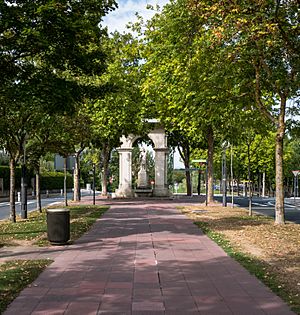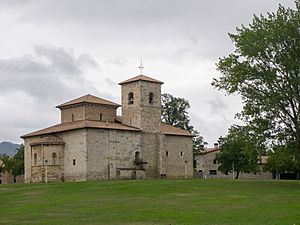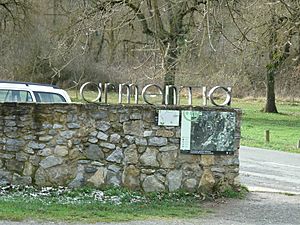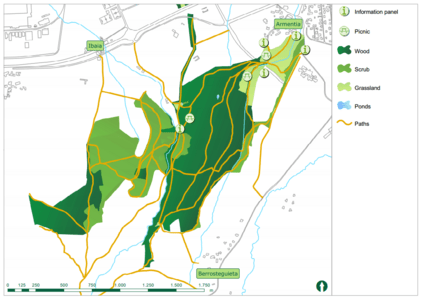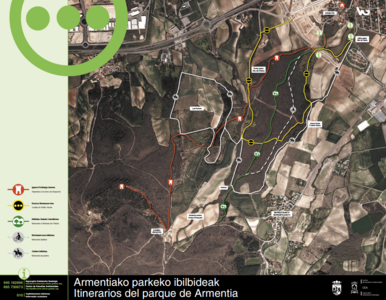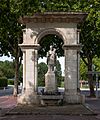Armentia facts for kids
Quick facts for kids
Armentia
|
|
|---|---|
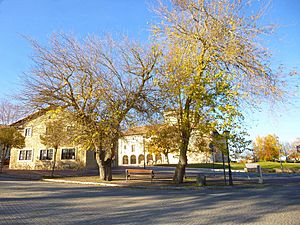 |
|
| Country | |
| Autonomous Community | |
| Province | |
| Comarca | Cuadrilla de Vitoria |
| Elevation
(AMSL)
|
550 m (1,800 ft) |
| Population | |
| • Total | 215 |
| Time zone | UTC+1 (CET) |
| • Summer (DST) | UTC+2 (CEST) |
| Postal code |
01007
|
| Area code(s) | +34 (Spain) + 945 (Álava) |
| Official language(s) | Spanish, Basque |
Armentia is a small village located near the city of Vitoria-Gasteiz in Spain. Its name comes from the Latin word armentum, which means "intensive farming". This village is famous for its large park, which was created in 1998 and covers 161 hectares. The northern part of Armentia borders the Ariznavarra neighborhood.
Contents
Armentia: A Historic Village Quarter
Armentia was once a separate village in the Álava province of the Basque Country. Today, it has become a quarter of Vitoria-Gasteiz as the city has grown.
Armentia's Past: A Center of Faith
During the Middle Ages, Armentia was a very important religious place in Álava. It was home to the bishop, and its church served as the first cathedral in the Basque Country. This was true until the late 1000s, when much of southern Spain was under Muslim rule. Later, the bishop's main office moved to Calahorra.
Armentia was also a key location for travel and trade in both Roman times and the late Middle Ages. Two major routes crossed here: the Way of St. James, which led towards Gometxa, and an old Roman road. This Roman road passed by the Mariturri Spring and continued towards Zuazo, then to Lermanda, Margarita, and finally to Iruña.
The Basilica of San Prudencio
Armentia is home to the Basilica of San Prudencio de Armentia, one of the most important Romanesque churches in the province. It was built in the 12th century. In the Middle Ages, people saw it as the most important spiritual center in Álava. The church you see today has a Latin cross shape, a transept (the part that crosses the main body), and a semicircular apse (a rounded end).
How Armentia's Population Changed
The number of people living in Armentia has changed over the years. Here's a quick look at the population from 2000 to 2007:
| 2000 | 2001 | 2002 | 2003 | 2004 | 2005 | 2006 | 2007 |
|---|---|---|---|---|---|---|---|
| 215 | 221 | 222 | 217 | 225 | 222 | 213 | 227 |
Armentia Park: A Green Oasis
Armentia Park is a large natural forest made mostly of gall-oak trees. It sits between the city of Vitoria-Gasteiz and the Mountains of Vitoria. These mountains are a main mountain range and a very valuable natural area in the region. Because of its location, Armentia forest acts like a natural bridge, connecting different forested areas, green spaces around the city, and the city's own environment. This connection is what makes Armentia Park so special.
Plants and Animals in Armentia Park
A big part of Armentia Park is its natural forest, covering 104 hectares. This is more than 70% of the park's total area. The main tree species in the forest is the gall oak. Over the last 25 years, the park has grown even more. Many different types of trees have been planted on 40 hectares of land that used to be farms.
The forest has several different kinds of environments. Some areas have very thick plants, with gall oaks, maples, hawthorns, blackthorns, and blackberry bushes. Other areas have trees that are more spread out, with large open spaces. In these clearings, you can find heather, badassi, and juniper.
In the Artetxo sitting area, you can see some amazing old gall oaks. They have a unique "candelabra-like" shape. This shape comes from years of pruning them for firewood. On the higher ridges, you might find beech trees, holly, and rowan. Along the small streams that flow through the park, maple, hazel, and ash trees are very common.
The park's different environments are home to many kinds of animals. You might see wild boars, squirrels, and birds of prey. There are also about 30 types of small birds, such as goldfinches, chaffinches, robins, and great tits. The park's natural value comes from being an important path for wildlife between the city's green areas and the Mountains of Vitoria.
How Armentia Park Was Developed
Years ago, fires and too much logging left the Armentia forest in poor condition. In 1974, the Provincial Council of Álava, which owns the land, started working to improve the gall oak wood. They also began creating a botanical park in areas where trees had been cut down. They planted native trees along with some more unusual plants and trees. Many of the maples, rowan trees, and cypresses you see today were planted during that time.
By the mid-1990s, the forest showed clear signs of damage. There was a lot of trash, leftover bonfires, too many paths, and many areas that were eroded or flooded. Too many visitors, especially vehicles, were the biggest threat to the park. The natural gall oak wood had many small, bushy trees, but few well-grown, mature ones.
After Armentia Park became part of the Green Belt, the first step was to fix the paths. They improved the main trails and closed smaller ones. They also created new paths for people walking, cycling, and riding horses. Damaged areas, like trash dumps, eroded spots, and riverbanks, were repaired. Additionally, parking areas were made at the main entrances, and two sitting areas were created for visitors.
Work to take care of the forest has been, and still is, very important. This ongoing effort helps keep Armentia Park in the healthy condition it is in today.
Maps and Views of Armentia Park
Images for kids
See also
 In Spanish: Armentia (Álava) para niños
In Spanish: Armentia (Álava) para niños



